|
"Another recent find from
East Timor (island state located about 400
miles northwest of Darwin, Australia)
with a surprisingly early date is an edge ground Tridacna shell adze/axe
found imbedded in the road surface near the township of Tutuala. A
section of the adze was directly AMS dated to 8,600 +- 245 BP."---------2006,
Sue O'Connor, Uncovering Southeast Asia's Past, Selected Papers,
"Unpacking The Island Southeast Asian Package Neolithic Cultural
Package, And Finding Local Complexity," p. 81.
"Large heavy Tridacna and Hippopus shell adzes
are found in Golo Cave on Gebe Island (Indonesia)
in levels dating to between 13,000 to 8,000 BP and adzes of comparable
age and form have been found in Pamwak Cave in the Admiralty Islands."---2006,
Sue O'Connor, Uncovering Southeast Asia's Past, Selected Papers,
"Unpacking The Island Southeast Asian Package Neolithic Cultural
Package, And Finding Local Complexity," p. 81.
"In Polynesia the Neolithic adze technology arrived in a well
developed form with the first men to settle this Archipelago. There is
no progression from simpler Pre-Neolithic forms."---1970,
Roger Duff, "Stone Adzes Of South East Asia," p. 7.
"Tridacna shell
adzes were in use on Manus (island, province
of Papua New Guinea) on evidence from
the Pamwak site 7,000 and possibly up to 10,000 years ago."---2006,
Wilhelm G. Solheim II,
"Archaeology And Culture In Southeast Asia: Unraveling The Nusantao,
p. 122.
"Duyong Cave, near the Tabon Caves of Palawan's western coast (Philippines)
produced a "Neolithic Burial" with four Tridacna shell adzes and two
different types of shell ornaments as well as other types of shell tools.
The calibrated Carbon 14 date for the burial is 3,675 - 3,015 B.C. and
4,575 - 4,425 B.C. for a nearby fire hearth that also had shell debris
associated with it"---2006,
Wilhelm G. Solheim II,
"Archaeology And Culture In Southeast Asia: Unraveling The Nusantao,
p. 120.
"The giant clam, Tridacna gigas is the largest
living bivalve mollusc. "---2010,
Wikipedia.

TRIDACNA SHELL
ADZES
NEOLITHIC
SOUTHEAST ASIA & PACIFIC OCEAN
Adzes have been used
everywhere on the planet for cutting trees and carving wood. In fact,
they have been in continuous use for thousands of years. The majority of
all prehistoric adzes ever produced were made from stone. But there are
exceptions. Especially those made by people who lived in the coastal
areas of southeast Asia and islands in the Pacific Ocean. The most
unique examples of adzes are the ones made from the shell of giant
clams.
|
|
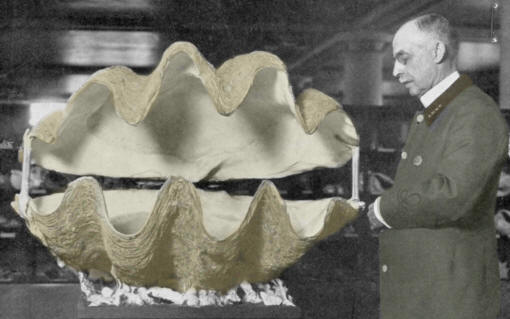
TRIDACNA
CLAM SHELL
PACIFIC OCEAN
The giant clam in this picture belongs to a Tridacna gigas
shellfish. It measures three feet across and weighs more than 400
pounds. Tridacna gigas is the largest living bivalve mollusc known.
The largest known Tridacna gigas specimen was recorded off the
western coast of Sumatra. The two shells weighed 507 pounds (230
kilograms). Its live weight was estimated to be about 551 pounds
(250 kilograms). But another unidentified large clam from the
Japanese island of Ishigaki weighed 734 pounds (333 kilograms). Its
live weight was estimated to have been 750 pounds (340 kilograms). Shell
adzes and gouges were made from the large hinge located at the back
of the shell and from the folds of the shell. |
|
|
A wide range of different types and sizes of shell was used
by ancient cultures who populated the many island in the Pacific Ocean.
Shell is a strong material that was used to make jewelry and tools for
fishing and cutting wood. The largest and thickest pieces of shell were
taken from Tridacna gigas clams and used to make adzes and gouges. |
|
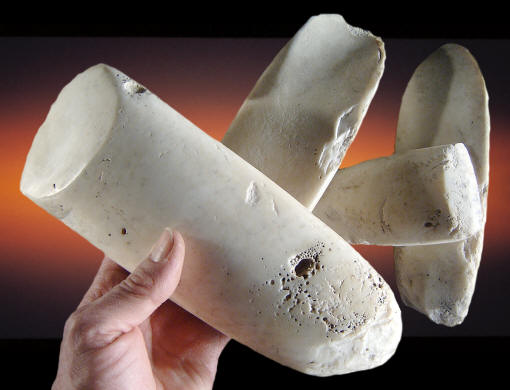
TRIDACNA SHELL ADZES &
GOUGE
STEWART ISLANDS, MELANESIA &
MICRONESIA
PACIFIC OCEAN
These four wood cutting tools were
made from large clam shells. At least two of them were probably made
from Tridacna gigas shell, which is the largest of the giant clams.
These tools were hafted onto wooden handles with the cutting edges
perpendicular to the handle and used as adzes and a gouge. The
second example from the from is a gouge. The largest adzes in this
picture measures 9 5/8 inches (24.5 cm) long, 3 9/16 inches (9 cm)
wide and 1 13/16 inches (4.6 cm) thick. |
|
|
Tridacna gigas is the largest living bivalve mollusc known.
The largest known Tridacna gigas specimen was recorded off the western
coast of Sumatra. The two shells weighed 507 pounds (230 kilograms). Its
live weight was estimated to be about 551 pounds (250 kilograms). But
another unidentified large clam from the Japanese island of Ishigaki weighed 734 pounds (333 kilograms). Its
live weight was estimated to have been 750 pounds (340 kilograms). |
|
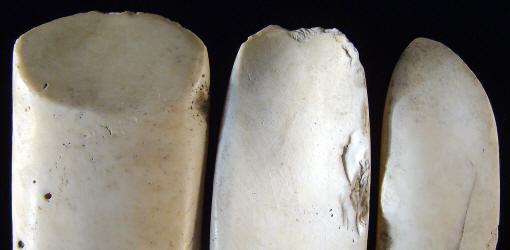
CLICK ON PICTURE FOR LARGER IMAGE
DIFFERENT TYPES OF CUTTING EDGES
ADZES & GOUGE
STEWART ISLANDS, MELANESIA &
MICRONESIA
PACIFIC OCEAN
This
picture shows examples of three Tridacna shell adzes and a gouge.
The cutting edges on shell adzes were made in several different
shapes. Some blades have straight edges with a single bevel from one
side. Some are "beaked" or pointed at the center of the
cutting edge. Other examples have a rounded cutting edge. The gouge
in the center of this picture has a rounded cutting edge and it's
sharpened by hollowing out more of the center which gives it a
U-shaped cross section. The large adze at the left measures
3 9/16 inches (9 cm) wide. |
|
|
Shell adzes have been found in a wide area along the coastal
waters of southeast Asia and on islands in the Pacific Ocean. There is a
report of a Tridacna shell adze from a small island in the China Sea as
far north as the People's
Republic of China. But they are widely reported from the regions in the
Pacific Ocean that make up the island groups of Micronesia, Melanesia
and Polynesia. |
|
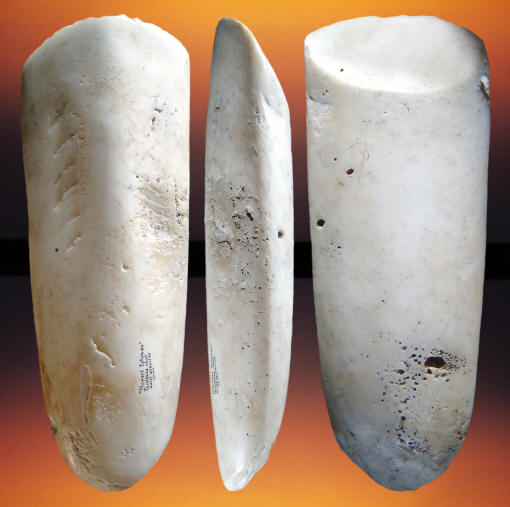
CLICK ON PICTURE FOR LARGER IMAGE
LARGE TRIDACNA SHELL ADZE
STEWART ISLANDS, MELANESIA
PACIFIC OCEAN
This very large Tridacna shell adze
was collected by a World War II Navy construction worker (Seabee) while
building an air strip on one of the Stewart Islands in Melanesia.
It's been ground and polished to a nice oval shape.
One side has a prominent dorsal ridge down its length. The cutting
edge is rounded and was formed by beveling from one side. This adze
measures 9 5/8 inches (24.5 cm) long, 3 9/16 inches (9 cm) wide and
1 13/16 inches (4.6 cm) thick. |
|
|
Some sites have produced shell adzes that are suspected to be
quite old. Solheim writes that, "Tridacna shell adzes were in use on
Manus (Island Province, Papua New Guinea) on evidence from the Pamwak
site 7,000 and possibly up to 10,000 years ago." Another site at Duyong
Cave in the Philippines produced a Neolithic burial with four Tridacna
shell adzes. The Carbon 14 date for the burial is 3,675 to 3,015 B.C.
and 4,575 to 4,4425 B.C. for a nearby fire hearth that also had shell
debris with it. But shell adzes were in use up to European contact. |
|
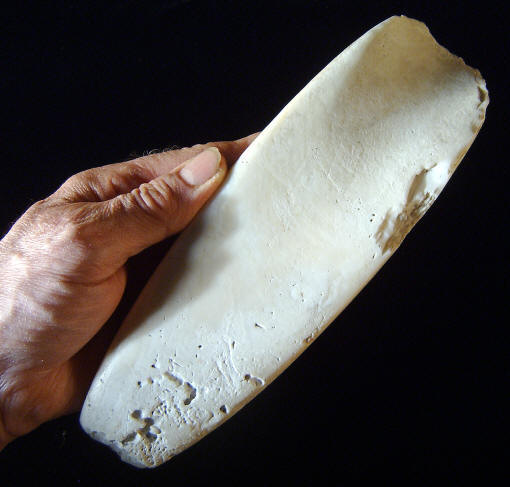
TRIDACNA SHELL GOUGE
STEWART ISLANDS, MELANESIA
PACIFIC OCEAN
This very large Tridacna shell gouge
was collected by a World War II Navy construction worker (Seabee)
while building an air strip on one of the Stewart Islands in
Melanesia. This gouge has a polish over it's entire surface. It is
triangular in cross section and it has a dorsal ridge along the
length of one side. The rounded cutting edge is formed by grinding
away and hollowing out more of the shell in the center which gives
it a typical U-shaped
cross section. This gouge measures 8 13/16 inches (22.6
cm) long, 2 13/16 inches (7.1 cm) wide and 1 7/16 inches (3.7 cm)
thick. |
|
|
Shell adzes are very efficient tools for cutting wood as some
early witnesses reported from their travels to Pacific island locations.
One account written in the 1800's wrote, "I noticed a large canoe being
shaped by two or three workers with their sharp Tridacna shell
adzes.----I saw they were going at it fairly rapidly; each blow of the
shell adze sent fairly large chips of wood flying." |
|
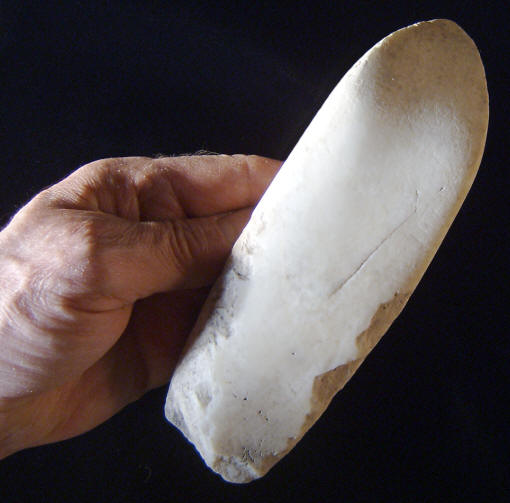
TRIDACNA SHELL ADZE
MICRONESIA
PACIFIC OCEAN
This adze is reported to have been
collected from one of the islands in Micronesia. This adze is made
from a thick section of Tridacna shell. The cutting edge is rounded
and comes to a "beaked" point in the center that was formed by
beveling from one side. This adze measures 7 1/8 inches (18.1 cm)
long, 2 3/8 inches (6.1 cm) wide and 1 3/8 inches (3.5 cm) thick. |
|
|
There are two locations on a giant clam that produces the
largest pieces of shell. One is at the hinge and the other is at the
ribs. Sections cut from these locations provide the thickest pieces of
shell and the largest adzes. |
|
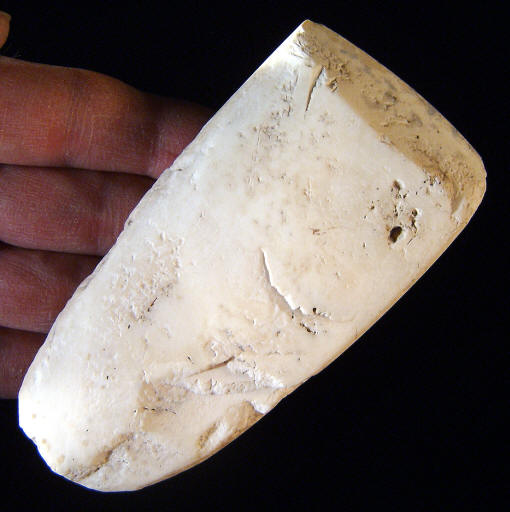
TRIDACNA SHELL ADZE
MICRONESIA
PACIFIC OCEAN
This small shell adze is reported to
have been collected from one of the islands in Micronesia. It has
been ground to a uniform rectangular shape. The straight cutting
edge was formed by a single bevel from one side. This adze may be
made from Tridacna shell and it measures 4 9/16 inches (11.6 cm)
long, 2 1/4 (5.8 cm) wide and 11/16 in (1.8 cm) thick. |
|
|
Shell adzes were made by percussion flaking and grinding. A
piece of shell was extracted from the main shell by either direct
percussion flaking or possibly by sticking against an anvil underneath
as in bipolar percussion flaking. The final shaping and finishing work
was done by either grinding the shell against a wet abrasive surface
such as sandstone or by grinding against loose wet sand placed on a hard
surface. |
|
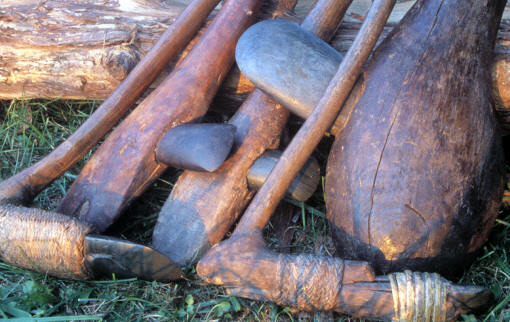
CLICK ON PICTURE FOR LARGER IMAGE
STONE AXES AND ADZES
NEW GUINEA
This picture shows three examples of
hafted stone axes and two examples of adzes from New Guinea. The two
adzes are at the bottom. Adzes were attached to wooden handles with
the cutting edge mounted at right angles to the handle. |
|
|
People have always taken advantage of their local natural
resources to provide themselves with shelter, food, clothing and tools.
Some of those materials seem "exotic" to us today but to the people
using them it was a perfect symbiosis. As an example, the mammoth bone
house structures made during the Paleolithic period in the Czech
Republic, Poland and the Ukraine certainly are impressive and also seem
very "exotic." But shell adzes made from pieces cut from Tridacna shells weighing hundreds of
pounds have to be one of the most unique materials ever used to
manufacture a wood cutting tool. |
|
"REFERENCES"
1970, Duff, Roger, "Stone Adzes Of
South East Asia," p. 7.
2006, O'Connor, Sue, Uncovering Southeast Asia's Past, Selected Papers,
"Unpacking The Island Southeast Asian Package Neolithic Cultural
Package, And Finding Local Complexity," p. 81.
2006, Solheim II, Wilhelm G.,
"Archaeology And Culture In Southeast Asia: Unraveling The Nusantao,
pp. 120 & 122.
|
|
RECENT
LISTINGS HOME
ORDERING |